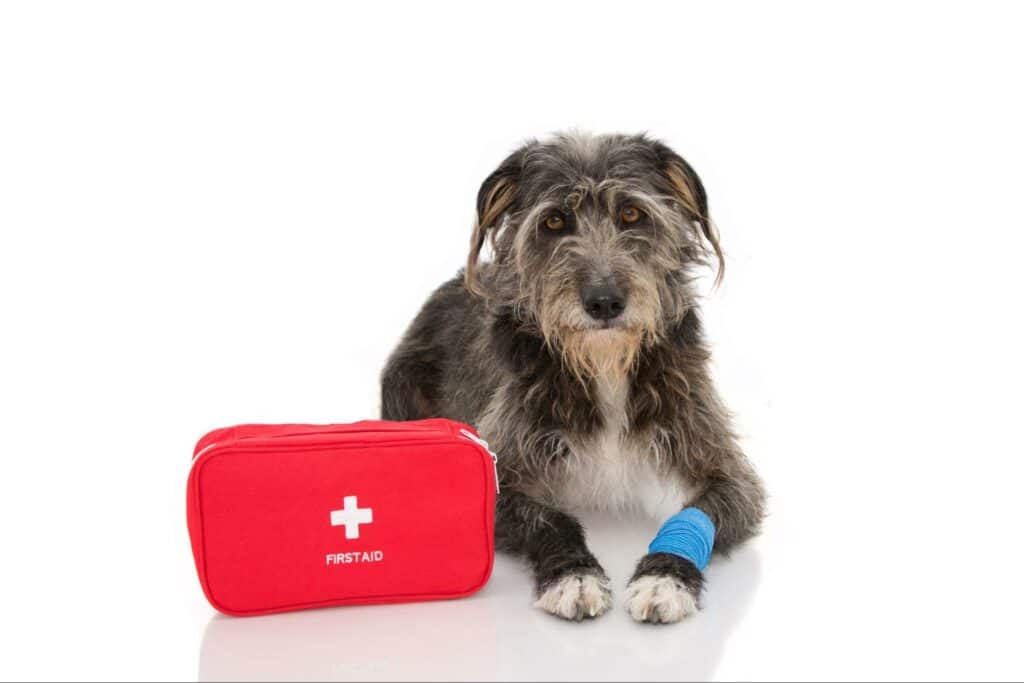Do you have everything you need in case of an emergency with your dog? Many people assume they will take their pet to the vet if something goes wrong, but what if you can’t get there in time? All good dog parents want to keep their pups safe, which means being prepared for potential doggie disasters. One of the best ways to be ready is to create a first aid kit for your four-legged friend.
First Aid Kit Items
What exactly do dogs need in a first aid kit? Some of the items are probably obvious, but others may be more surprising. That’s why we decided to put together this comprehensive list of what you should include and why.
Wound Spray
Your dog can get cut, scratched, or otherwise suffer injury to its skin, both around the house and outdoors.
Self-Cling Bandage
If your dog suffers a severe laceration or other injuries, you’ll probably want to cover it with a bandage after using the wound spray. Look for self-cling bandages that won’t stick to your dog’s fur to avoid painful removal later.
Bandage Scissors
Unless you want Fido to look like a mummy when you bandage him, include a pair of bandage scissors in your kit designed to cut through gauze, clothing, and (yes) bandages.
Antibiotic Ointment
If your pup gets cut or scratched, the injury needs to be treated immediately. Antibiotic ointments will help prevent infection and relieve pain while also acting as a barrier from bacteria for them not to become septicemic (a severe condition caused by an untreated wound).
Eye Wash and Ear Wash
If your dog gets some pollutant or other contaminants in her eyes or ears, it can cause itching, stinging, burning, or worse. Dog-safe eyewash and ear wash can help you flush out the problem materials with a dropper nozzle and even be used on any dressing needed.
Flashlight
A flashlight might be one of the items you didn’t consider adding to the first aid kit, but it could be helpful when you’re trying to pull out a splinter or drop a pill. Keep extra batteries on hand or invest in a solar-powered flashlight. If you choose a solar flashlight, make sure you store it in a location that has plenty of sunlight.
Rubber Gloves
Rubber gloves are recommended for any medical emergency. Always wear protective gear when dealing with blood or bodily fluids!
Grooming or Wet Wipes
Wipes are a must-have for every pet owner. You can use them before getting in the car after an accident has occurred and when cleaning dirt or blood off wounds to get better visibility to see the injury.
Dog Cone
The problem with eye and other head-related issues is that your pup will do whatever he can to scratch and rub at the area with his paw. Prevent this from happening by using a dog cone, which will also prevent your dog from being able to chew at stitches from surgery or lick at a hot spot during treatment. Your vet may also refer to this as an Elizabeth Collar or e-collar for short.

A Comfort Item
When you find yourself in a high-stress situation with your pet, such as during an incredibly traumatic event or severe storm, it’s essential to have something they can clutch onto to make them feel safe and comforted while witnessing this difficult moment.
Keep any old favorite toy or blanket handy, so it is available when needed! The sight of these cherished objects may help settle down your pup in an uneasy situation.
Muzzle
Even a normally calm and balanced dog may lash out when injured, and he may also bite at a wound, making it worse. Like the Funny Muzzle, muzzles serve the dual purpose of keeping a nervous or aggressive dog from harming others or bringing harm to himself.
Leash
A leash is an essential tool to have in your first aid kit because it’s a way for you, as the owner of your dog, to gain control when they may be panicking and try running away. You want this item because the focus isn’t solely on keeping them from fleeing but also on assessing any injuries sustained before determining how best to administer first aid.
Hydrogen Peroxide
If your dog consumes poison, you might not have time to get them to the vet. Depending on the poison, making your dog vomit can be a vital tactic until you get them to treatment. One safe and effective way to induce vomiting and get the poison out of their system is to force them to drink hydrogen peroxide. Always keep a fresh bottle on hand.
But don’t assume that hydrogen peroxide is the answer in every situation. Your best bet is to call the Pet Poison Helpline at (800) 213-6680 to get their recommendation on how to handle the situation right.
Water and Treats
Keep a bottle of water for your dog in case you don’t have access to their regular supply and keep an emergency stash of food ready. You can also give a reward after allowing you to remove thorns or ticks from their body, such as biscuits (or any other treat).
Medications
Talk to your vet about keeping an extra supply of any prescribed medications in the first-aid kit.
If you are traveling, the pet emergency kit will have a backup of all medications. It is always good to have some over-the-counter medicines that your vet approved. These include flea and tick meds, antacids, or drugs for stomach issues in case of an emergency on the road!
Important Phone Numbers
You want to be able to reach help fast in an emergency. Include the phone number for your veterinarian, your emergency vet clinic, and the ASPCA poison control center: (800) 426‑4435. We suggest putting this information inside a clear plastic cover to prevent water damage.
Medical Records
If you have to take your dog to seek help from someone other than his regular veterinarian, it can be valuable to provide them with his medical background and proof of his rabies vaccine.
With these items, you’ll be prepared to help your dog through the most dangerous situations they’re likely to encounter, but remember, it’s always best to seek veterinary care. A first aid kit should be used to remediate an emergency until you get to the vet or address minor injuries like a superficial wound. Ultimately, having a well-prepared kit takes some forethought and planning on the part of pet owners. But with its many benefits for our animal companions, it is worth the effort! So whether you’re at home or out on the road with your furry friend, make sure that you have a well-stocked kit.











